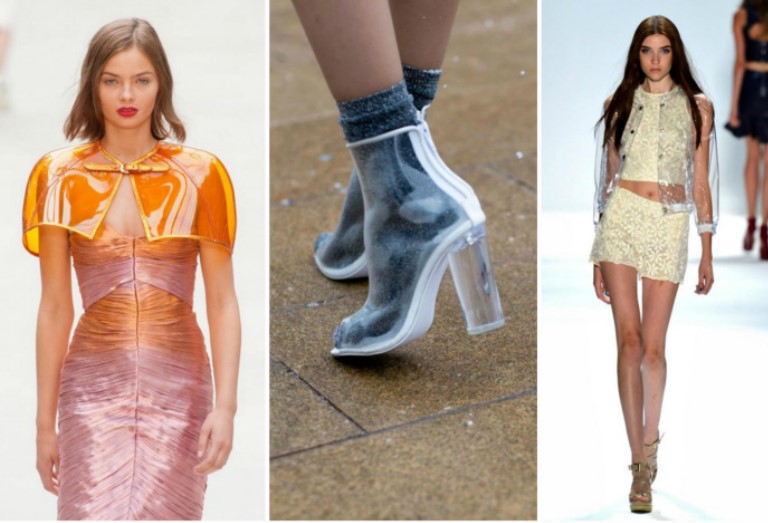Plastic has long been firmly established in the world market as a universal raw material. It is used to make toys, packaging materials, dishes, stationery, furniture and a lot of other things. The fashion industry is no exception: this material is used to create clothes, shoes and various accessories.
Plastic in clothes: how did couturiers get to this point?
 Achievements of scientific and technological progress, the polarity of tastes and preferences of consumers, and the desire to emphasize their own individuality inspire fashion designers to bold experiments. They began creating plastic clothes in the first half of the 20th century after the release of the first futuristic films on cinema screens.. In the 60s, their desire to design “clothes of the future” was strengthened by the successes of scientists and military personnel in space exploration.
Achievements of scientific and technological progress, the polarity of tastes and preferences of consumers, and the desire to emphasize their own individuality inspire fashion designers to bold experiments. They began creating plastic clothes in the first half of the 20th century after the release of the first futuristic films on cinema screens.. In the 60s, their desire to design “clothes of the future” was strengthened by the successes of scientists and military personnel in space exploration.
Today, in order to rise to the top of the fashion Olympus, to win and maintain customer interest in their brand, a couturier has to be in constant creative search.“Conjuring” with various materials, styles, and accessories, they sometimes find the most unexpected and original solutions for their fashion collections. Plastic clothing reflects the main trends of new times and is gaining more and more popularity every year. Its advantages include:
- ease of care - to return things to their original appearance, just wipe it with a damp cloth;
- waterproof;
- relatively low price (except for luxury items).
Trend or anti-trend?
 It's hard to say for sure. For many people, this is, of course, a trend that allows them to look extraordinary, standing out from the rest of the people and attracting attention with an ultra-fashionable “outfit.” But there are also opponents of artificial materials who deliberately prefer natural fabrics to synthetic ones.
It's hard to say for sure. For many people, this is, of course, a trend that allows them to look extraordinary, standing out from the rest of the people and attracting attention with an ultra-fashionable “outfit.” But there are also opponents of artificial materials who deliberately prefer natural fabrics to synthetic ones.
Even environmentalists cannot agree among themselves. Some consider plastic clothing to be a blessing, since it is often made from recycling recycled materials - used plastic (bottles, plates, cups). Others are confident that “plastic rush” will lead to an increase in the production of this material and, consequently, to more environmental pollution.
Ultimately, the decision to wear or not wear plastic is made by each person based on their own beliefs, convenience and aesthetic needs.
What is made from plastic?
This material perfectly protects from bad weather, preventing you from getting wet even in the heaviest downpour, so the most popular item in our wardrobe can be called raincoat. All inhabitants of the planet periodically put on it, as necessary, regardless of age and social class.However, a raincoat is far from the limit of the capabilities of this synthetic raw material, from which you can sew anything you want. The range of products is constantly expanding:
 A waterproof jacket or trench coat is a more modern alternative to a raincoat. It features a sophisticated cut, interesting texture, and is decorated with stylish fittings;
A waterproof jacket or trench coat is a more modern alternative to a raincoat. It features a sophisticated cut, interesting texture, and is decorated with stylish fittings;- a cap or hat will help protect your hair from rain and perfectly complement the look;
- a transparent or colored dress in the futurism style will be the highlight of the party;
- a straight or loose-fitting skirt is suitable for young and slender girls;
- trousers and shorts will appeal to the most extravagant fashionistas;
- a variety of shoes - from sandals to ankle boots and over the knee boots. In closed models, you can safely walk through puddles without fear of getting your feet wet;
- A belt or corset can also be an interesting addition to the look if you wear it with a plain T-shirt, dress or coat.
Combined items, where plastic is only part of the product, are also popular among designers. For example, jeans with holes in the knees, decorated with plastic “windows”.
How to wear THIS correctly?
The main disadvantage of plastic is that it is a completely artificial material. It does not allow air to pass through and does not allow the body to “breathe”. To avoid the greenhouse effect, you need to follow some rules.
Can be worn:
 choosing cloudy, cool, rainy weather to go out;
choosing cloudy, cool, rainy weather to go out;- on top of “breathable” items made from natural textiles. For example, the skirt can be worn over light shorts, and the dress over another, for example, a cotton dress. Many designers specifically create multi-layer outerwear models with a plastic shell.
Not recommended:
- putting plastic things on your naked body;
- wear in sunny hot weather, as well as for a long time;
- use toxic plastic for sewing.
In general, if there are no medical contraindications, You can wear plastic clothes to a short evening event or walk in the rain. Those who find this clothing uncomfortable can show off to their friends a nice handbag, wallet or original plastic jewelry.














 0
0





